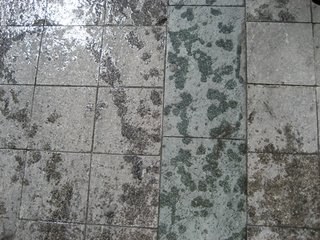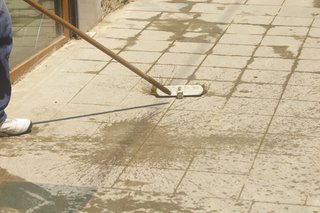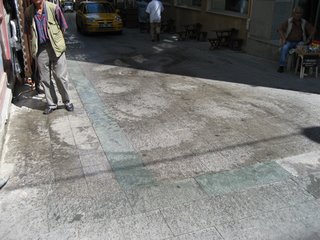
The first thing one notices about watering the street is the decadence of the practice in a hot climate with only marginal access to potable water for the 12 million people that live here. Or maybe it’s as good a use as any for the tap water often containing bacteria from the aging plumbing rendering it unsanitary for many. Regardless, there is also a question of whether or not there is an improvement. If you ask any shop owner he will tell you that it keeps the dust down. After all, the streets are unquestionably dusty, but do they really need to be muddy? The slick of water and street filth make walking slippery and arguably unhygienic. When you get home and knock the collected muck off your shoes it is hard to reminisce about the aesthetic value of the grime turning your new shoes black. The standing water only contributes to the miasma that afflicts the city on hot summer days.
On Sunday mornings the full scale cleaning of the streets occurs. Shops bring out the hoses, squeegees and soap and really scour their stoops. It is an impressive sight, the public way cleaned in so many small pieces, with each contribution adding to the small river running down the center of the inversely crowned street. Thus, the middle of the street is rendered off limits, a collective stream of street washings.
The municipal authorities are complicit in this practice. Streets are carefully constructed in order to capture any water that doesn’t turn to steam and shed it from the premises. In many of the old neighborhoods this is quite a challenge; the cacophony of dimensions, angles and intersections makes standardization more than a challenge. Ultimately, the square paver of Turkish granite becomes the building block of the larger street. The square is adaptable to be laid in any direction and is easily broken to create all of the unique shapes needed at any of the myriad changes in direction. Pavers are laid by hand using strings struck between guide rods and the resulting street is sloped subtly to a swale to guide the runoff to various city drains. Old world technique results in a largely effective machine.
And the ablutions go on. The splattered moiré reclaims the street every day as the sun gets high and hot, and the foot traffic gets heavy and relentless. It is wiped and smeared by the teaming pedestrians and vehicles, and dries quickly in the intense summer heat. A rug merchant near Sultanahmet drizzles intricate figure-8’s, while the manager of Şark restaurant in Beyoğlu splashes wide heavy arcs. This ephemeral graffiti on the city streets appears as quickly as it disappears. It makes you jump, dance and slip, adding another layer to this already most multi-layered of cities. As the last blotches steam from the pavers, the shop owner returns with his water bottle and creates another sudden masterpiece or mess, depending on his degree of pride and flourish.
-




